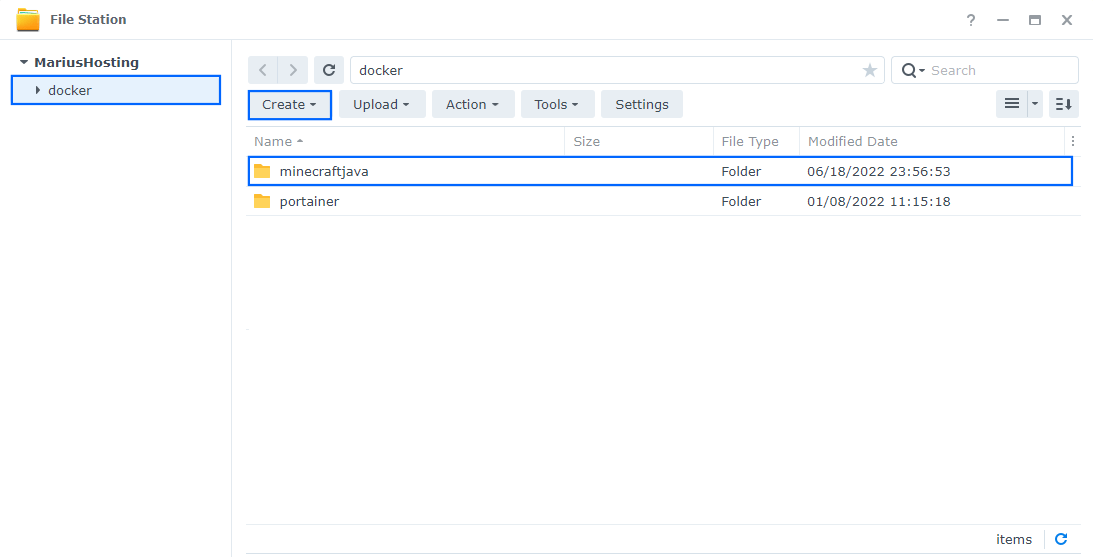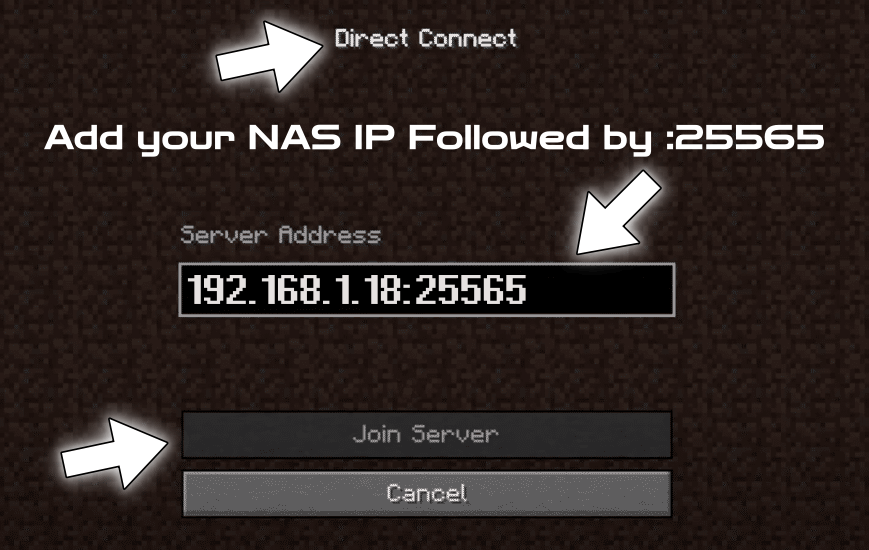
Minecraft servers allow players to play online or via a local area network with other people. Internally, the game runs a server for single-player games. If you want to run a Minecraft multiplayer server by yourself, then you have come to the right place. After many requests from Minecraft fans, I’ve created installation instructions for Synology NAS. In this step by step guide I will show you how to install Minecraft Java Server on your Synology NAS using Docker & Portainer. If you want an alternative to Minecraft, try the Minetest installation on your Synology NAS or the new Minecraft Bedrock guide.
STEP 1
Please Support My work by Making a Donation.
STEP 2
Install Portainer using my step by step guide. If you already have Portainer installed on your Synology NAS, skip this STEP. Attention: Make sure you have installed the latest Portainer version.
STEP 3
Go to File Station and open the docker folder. Inside the docker folder create one new folder and name it minecraftjava. Follow the instructions in the image below.
Note: Be careful to enter only lowercase, not uppercase letters.

STEP 4
Log into Portainer using your username and password. On the left sidebar in Portainer, click on Home then Live connect. Follow the instructions in the image below.

On the left sidebar in Portainer, click on Stacks then + Add stack. Follow the instructions in the image below.

STEP 5
In the Name field type in minecraftjava. Follow the instructions in the image below.
services:
minecraft:
image: itzg/minecraft-server
container_name: Minecraft-Java
environment:
- UID=1026
- GID=100
- TYPE=PAPER
- SERVER_NAME=MARIUSHOSTING
- JVM_XX_OPTS=-XX:+UseG1GC -XX:+ParallelRefProcEnabled -XX:MaxGCPauseMillis=200 -XX:+UnlockExperimentalVMOptions -XX:+DisableExplicitGC -XX:+AlwaysPreTouch -XX:G1HeapWastePercent=5 -XX:G1MixedGCCountTarget=4 -XX:G1MixedGCLiveThresholdPercent=90 -XX:G1RSetUpdatingPauseTimePercent=5 -XX:SurvivorRatio=32 -XX:+PerfDisableSharedMem -XX:MaxTenuringThreshold=1 -XX:G1NewSizePercent=30 -XX:G1MaxNewSizePercent=40 -XX:G1HeapRegionSize=8M -XX:G1ReservePercent=20 -XX:InitiatingHeapOccupancyPercent=15
- MAX_MEMORY=4G
- EULA=TRUE
volumes:
- /volume1/docker/minecraftjava:/data:rw
network_mode: host
restart: on-failure:5
Note: Before you paste the code above in the Web editor area below, change the value numbers for UID and GID with your own values. (Follow my step by step guide on how to do this.)
Note: Before you paste the code above in the Web editor area below, change the value for TYPE and add your favorite Server type from the following list: VANILLA, BUKKIT, SPIGOT, PAPER, TUINITY, MAGMA, MOHIST, CATSERVER, CURSEFORGE, SPONGEVANILLA, FABRIC. In the example above I have used the PAPER server; you have to choose your own favorite server type.
Note: Before you paste the code above in the Web editor area below, change the value for SERVER_NAME and add your own server name. MARIUSHOSTING is an example of a server name; you have to add your own server name.

STEP 6
Scroll down on the page until you see a button named Deploy the stack. Click on it. Follow the instructions in the image below. The installation process can take up to a few minutes. It will depend on your Internet speed connection.

STEP 7
If everything goes right, you will see the following message at the top right of your screen: “Success Stack successfully deployed“.

STEP 8
🟢Please Support My work by Making a Donation. Almost 99,9% of the people that install something using my guides forget to support my work, or just ignore STEP 1. I’ve been very honest about this aspect of my work since the beginning: I don’t run any ADS, I don’t require subscriptions, paid or otherwise, I don’t collect IPs, emails, and I don’t have any referral links from Amazon or other merchants. I also don’t have any POP-UPs or COOKIES. I have repeatedly been told over the years how much I have contributed to the community. It’s something I love doing and have been honest about my passion since the beginning. But I also Need The Community to Support me Back to be able to continue doing this work.
STEP 9
Wait approximately 1-2 minutes, then try to access your own server via the Minecraft java edition. Go to Direct Connect, then add your NAS Local IP followed by :25565 and click Join Server. Follow the instructions in the image below.

⚠️Note: If you want to run the Minecraft Java Server container over HTTPS, check my guide on How to Run Docker Containers Over HTTPS. Remember to port forward port 25565 TCP/UDP on your router pointing to your NAS to make it accessible externally. In order to make Minecraft work via HTTPS, it’s mandatory to activate WebSocket. ⚠️Note: If you want to use your synology.me DDNS, in the apposite field just add minecraft.yourname.synology.me instead of the local NAS IP followed by :25565
This Minecraft server was successfully tested on Xbox and PlayStation 5.
Note: Find out how to update the Minecraft Java Server container with the latest image.
Note: Can I run Docker on my Synology NAS? See the supported models.
Note: How to Back Up Docker Containers on your Synology NAS.
Note: How to Free Disk Space on Your NAS if You Run Docker.
Note: How to Schedule Start & Stop For Docker Containers.
Note: How to Activate Email Notifications.
Note: How to Add Access Control Profile on Your NAS.
Note: How to Change Docker Containers Restart Policy.
Note: How to Use Docker Containers With VPN.
Note: Convert Docker Run Into Docker Compose.
Note: How to Clean Docker.
Note: How to Clean Docker Automatically.
Note: Best Practices When Using Docker and DDNS.
Note: Some Docker Containers Need WebSocket.
Note: Find out the Best NAS Models For Docker.
Note: Activate Gmail SMTP For Docker Containers.
This post was updated on Wednesday / November 26th, 2025 at 1:37 AM
